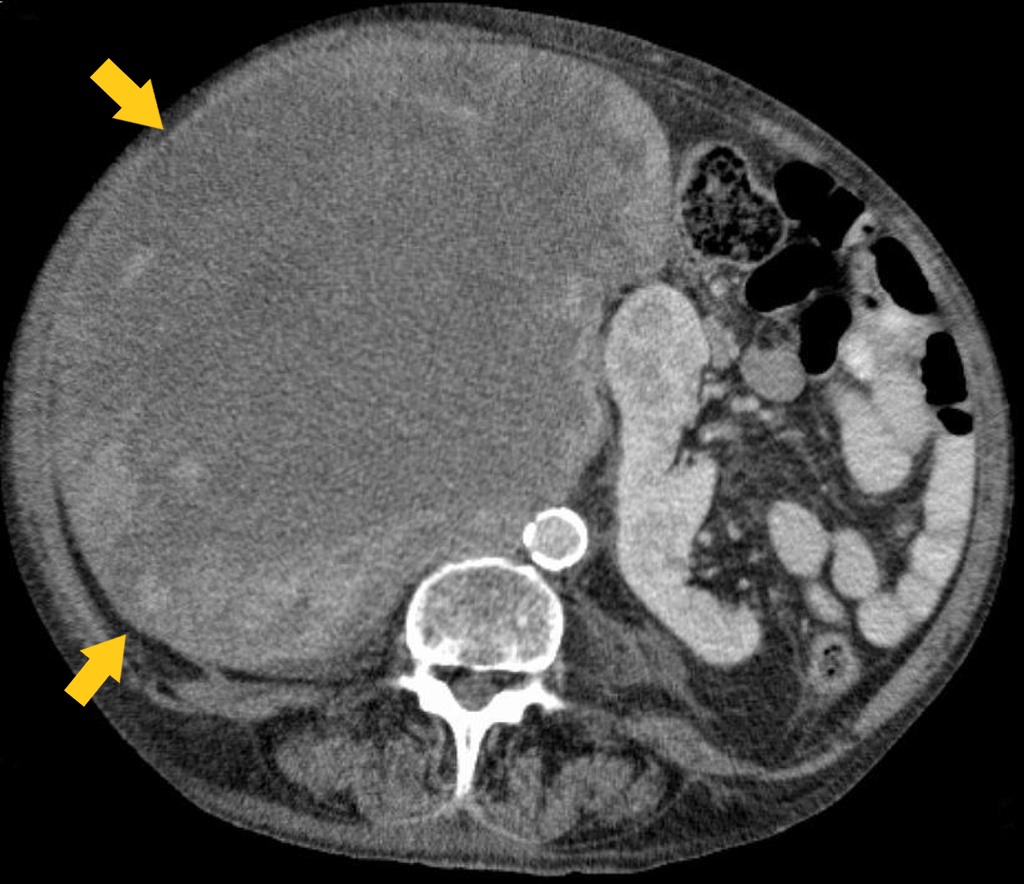Liposarcoma CT scan
Jump to navigation
Jump to search
|
Liposarcoma Microchapters |
|
Diagnosis |
|---|
|
Treatment |
|
Case Studies |
|
Liposarcoma CT scan On the Web |
|
American Roentgen Ray Society Images of Liposarcoma CT scan |
Editor-In-Chief: C. Michael Gibson, M.S., M.D. [1]; Associate Editor(s)-in-Chief: Alejandro Lemor, M.D. [2]Sabawoon Mirwais, M.B.B.S, M.D.[3]
Overview
CT scan is crucial for the diagnosis of liposarcoma. CT scan may detect regions of lipid and non-lipid components that correlate with histological sub-types of liposarcoma. CT scan can demonstrate the size, location, and depth of a liposarcoma, as well as lymph node involvement and distant metastasis.
CT scan
- A CT scan image commonly detects areas of focal or diffuse infiltration of lipid and non-lipid components.
- The appearance and morphologic relationship between the lipid and non-lipid components of a liposarcoma on CT scan frequently helps in identifying the specific histologic sub-type of liposarcoma.[1]
- CT scan also determines the size and depth of the tumor, stage of the disease, presence of lymphadenopathy, and evidence of distant metastasis.[2]
CT Scan Findings According to the Liposarcoma Sub-type
| Subtypes | Density | Margins | Fat Content | Nodular muscle-density area in tumor | Calcifications | Necrotic or cystic areas |
| Atypical lipomatous tumor/well-differentiated liposarcoma (ALT/WDL) | Fat | Smooth regular | > 65% | ++ | Few/none | + |
| Dedifferentiated liposarcoma (DDL) | Mixed | Rough irregular | 30 - 60% | +++ | Few/none | ++ |
| Myxoid/round cell liposarcoma (ML/RCL) | Mixed | Rough irregular | 25 - 50% | + | Common | +++ |
| Pleomorphic liposarcoma (PL) | Soft tissue | Incomplete irregular | 6 - 25% | + | Few/none | + |
| Mixed-type liposarcoma | Mixed | Smooth regular | 30 - 60% | ++ | Common | + |
| Table adapted from Lu J, Qin Q, Zhan LL, et al. Computed tomography manifestations of histologic subtypes of retroperitoneal liposarcoma. Asian Pac J Cancer Prev. 2014;15(15):6041-6.[3] | ||||||
Images

]
References
- ↑ Kim, T; Murakami, T; Oi, H; Tsuda, K; Matsushita, M; Tomoda, K; Fukuda, H; Nakamura, H (1996). "CT and MR imaging of abdominal liposarcoma". American Journal of Roentgenology. 166 (4): 829–833. doi:10.2214/ajr.166.4.8610559. ISSN 0361-803X.
- ↑ Kumarasamy, Narmadan A.; Gayer, Gabriela (2011). "Retroperitoneal Sarcomas". Seminars in Ultrasound, CT and MRI. 32 (5): 422–432. doi:10.1053/j.sult.2011.06.002. ISSN 0887-2171.
- ↑ Jing Lu, Qin Qin, Liang-Liang Zhan, Xi Yang, Qing Xu, Jing Yu, Li-Na Dou, Hao Zhang, Yan Yang, Xiao-Chen Chen, Yue-Hua Yang, Hong-Yan Cheng & Xin-Chen Sun (2014). "Computed tomography manifestations of histologic subtypes of retroperitoneal liposarcoma". Asian Pacific journal of cancer prevention : APJCP. 15 (15): 6041–6046. PMID 25124571.